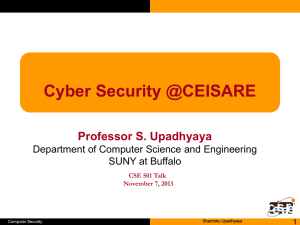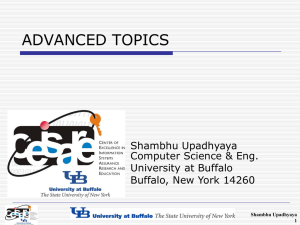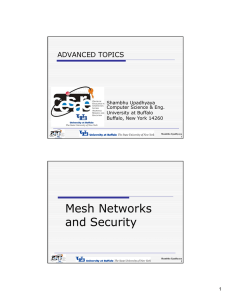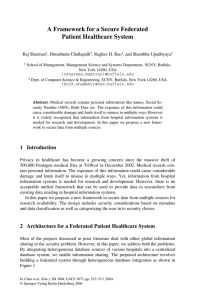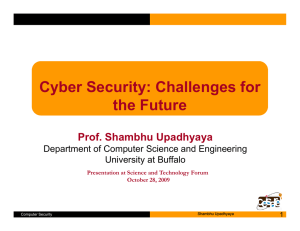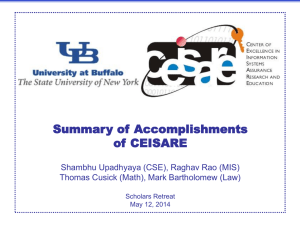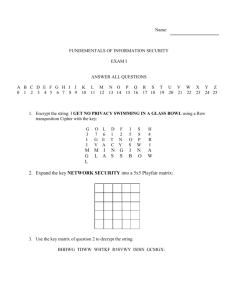Overview of Security Principles Shambhu Upadhyaya Wireless Network Security– Principles
advertisement
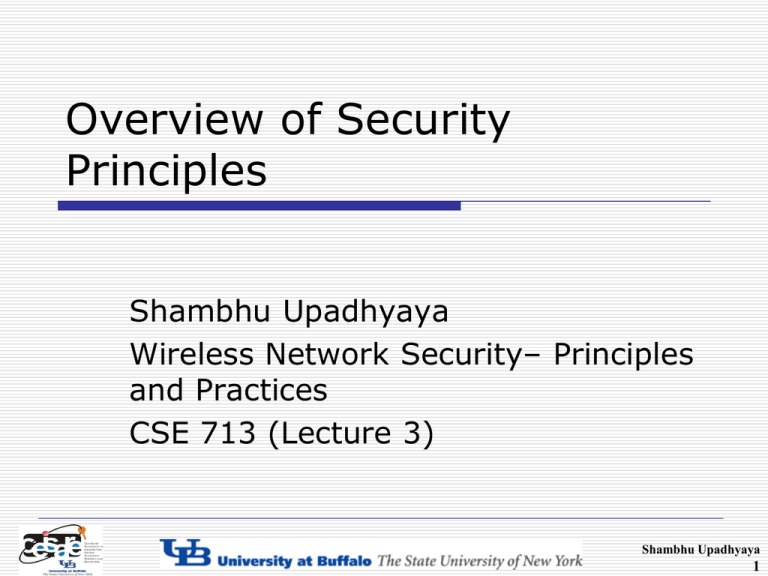
Overview of Security
Principles
Shambhu Upadhyaya
Wireless Network Security– Principles
and Practices
CSE 713 (Lecture 3)
Shambhu Upadhyaya
1
Outline
Basic Encryption Methodology
Message Authentication and Integrity
Program Security
Network Security
Intrusion Detection
Firewalls
Shambhu Upadhyaya
2
Popular Encryption Methods
Stream Ciphers
One Time Pad
RC4
Block Ciphers
DES/AES
RSA
RC5
Shambhu Upadhyaya
3
Stream Ciphers
Processes the message bit by bit (as a stream)
Typically has a (pseudo) random stream key
Combined (XORed) with plaintext bit by bit
Randomness of stream key completely destroys
any statistically properties in the message
Ci = Mi XOR StreamKeyi
Concept is very simple!
Stream key should not be reused
If reused the patterns can be used to reidentify the message
Shambhu Upadhyaya
4
Stream Cipher Properties
Some design considerations are:
Long period with no repetitions
Statistically random
Depends on large enough key
Large linear complexity
Correlation immunity
Confusion
Diffusion
Use of highly non-linear boolean functions
Shambhu Upadhyaya
5
RC4
A proprietary cipher owned by RSA DSI
Another Ron Rivest design, simple but effective
Variable key size, byte-oriented stream cipher
Widely used (web SSL/TLS, wireless WEP)
Key forms random permutation of all 8-bit
values
Uses that permutation to scramble input info.
processed a byte at a time
Shambhu Upadhyaya
6
RC4 Key Schedule
Starts with an array S of numbers: 0..255
Use key to well and truly shuffle
S forms internal state of the cipher
Given a key k of length l bytes
for i = 0 to 255 do
S[i] = i
j = 0
for i = 0 to 255 do
j = (j + S[i] + k[i mod l]) (mod 256)
swap (S[i], S[j])
Shambhu Upadhyaya
7
RC4 Encryption
Encryption continues shuffling array values
Sum of shuffled pair selects "stream key" value
XOR with next byte of message to en/decrypt
i = j = 0
for each message byte Mi
i = (i + 1) (mod 256)
j = (j + S[i]) (mod 256)
swap(S[i], S[j])
t = (S[i] + S[j]) (mod 256)
Ci = Mi XOR S[t]
Shambhu Upadhyaya
8
RC4 Security
Since RC4 is a stream cipher, must never
reuse a key
Used in SSL and WEP
Claimed secure against known attacks
Falls short of the standards of a secure cipher in
several ways, and thus is not recommended for
use in new applications
Fluhrer, Mantin and Shamir Attack can be used
to break the cipher
Shambhu Upadhyaya
9
Block Cipher Characteristics
Features seen in modern block ciphers are:
Variable key length/block size/no. of rounds
Mixed operators, data/key dependent
rotation
Key dependent S-boxes
More complex key scheduling
Operation of full data in each round
Varying non-linear functions
Shambhu Upadhyaya
10
DES Algorithm
Confusion and Diffusion
64 bit block cipher, plaintext is encrypted in blocks of 64
bits
Substitution and Permutation (Transposition)
56 bit key + 8 bit parity = 64 bit key
Repetitive nature – shift and xor
Outline
Split data in half
Scramble each half independently
Combine key with one half
Swap the two halves
Repeat the process 16 times
Shambhu Upadhyaya
11
DES Encryption
Shambhu Upadhyaya
12
One Round of DES
Li = R i-1
Ri = Li-1 xor F(Ri-1, Ki )
Shambhu Upadhyaya
13
AES (Advanced Encryption
Standard) Requirements
Private key symmetric block cipher
128-bit data, 128/192/256-bit keys
Stronger & faster than Triple-DES
Active life of 20-30 years (+ archival use)
Provide full specification & design details
Both C & Java implementations
NIST have released all submissions &
unclassified analyses
Shambhu Upadhyaya
14
Rijndael
Processes data as 4 groups of 4 bytes (state)
Has 9/11/13 rounds in which state undergoes:
byte substitution (1 S-box used on every byte)
shift rows (permute bytes between groups/columns)
mix columns (subs using matrix multiply of groups)
add round key (XOR state with key material)
Initial XOR key material & incomplete last round
All operations can be combined into XOR and table
lookups - hence very fast & efficient
Shambhu Upadhyaya
15
Rijndael
Shambhu Upadhyaya
16
Public Key Infrastructure
Based on mathematical functions
Asymmetric (two separate keys)
Enhances confidentiality, key distribution
and authentication
Ingredients are:
Plaintext
Encryption algorithm
Public and private keys
Ciphertext
Decryption algorithm
Shambhu Upadhyaya
17
RSA
RSA encryption and decryption are
commutative, hence it may be used directly as
a digital signature scheme
Given an RSA scheme {(e,R), (d,p,q)}
To sign a message, compute:
S = Md(mod R)
To verify a signature, compute:
M = Se(mod R) = Me.d(mod R) = M(mod R)
Thus know the message was signed by the
owner of the public-key
Shambhu Upadhyaya
18
RSA
Would seem obvious that a message may be
encrypted, then signed using RSA without
increasing its size
But have blocking problem, since it is
encrypted using the receiver’s modulus, but
signed using the sender’s modulus (which may
be smaller)
Several approaches possible to overcome this
More commonly use a hash function to create a
separate message digest which is then signed
Shambhu Upadhyaya
19
RC5
A proprietary cipher owned by RSADSI
Designed by Ronald Rivest (of RSA fame)
Used in various RSADSI products
Can vary key size / data size / no. of rounds
Very clean and simple design
Easy implementation on various CPUs
Yet still regarded as secure
Shambhu Upadhyaya
20
RC5 Ciphers
RC5 is a family of ciphers RC5-w/r/b
w = word size in bits (16/32/64)
data=2w
r = number of rounds (0..255)
b = number of bytes in key (0..255)
Nominal version is RC5-32/12/16
i.e., 32-bit words, so encrypts 64-bit data
blocks
using 12 rounds
with 16 bytes (128-bit) secret key
Shambhu Upadhyaya
21
RC5 Key Expansion
RC5 uses 2r+2 subkey words (w-bits)
Subkeys are stored in array S[i], i=0..t-1
Then the key schedule consists of
Initializing S to a fixed pseudorandom value,
based on constants e and phi
The byte key is copied (little-endian) into a
c-word array L
A mixing operation then combines L and S
to form the final S array
Shambhu Upadhyaya
22
RC5 Encryption
Split input into two halves A & B
L0 = A + S[0];
R0 = B + S[1];
for i = 1 to r do
Li = ((Li-1 XOR Ri-1) <<< Ri-1) + S[2 x i];
Ri = ((Ri-1 XOR Li) <<< Li) + S[2 x i + 1];
Each round is like 2 DES rounds
Note rotation is main source of non-linearity
Need reasonable number of rounds (e.g., 12-16)
Shambhu Upadhyaya
23
RC5 Modes
RFC2040 defines 4 modes used by RC5
RC5 Block Cipher, is ECB mode
RC5-CBC, is CBC mode
RC5-CBC-PAD, is CBC with padding by bytes
with value being the number of padding
bytes
RC5-CTS, a variant of CBC which is the
same size as the original message, uses
ciphertext stealing to keep size same as
original
Shambhu Upadhyaya
24
Message Authentication
Message authentication is concerned with:
Protecting the integrity of a message
Validating identity of originator
Non-repudiation of origin (dispute
resolution)
Can be provided by three methods:
Message encryption
Message authentication code (MAC)
Hash function
Shambhu Upadhyaya
25
Message Encryption
Message encryption by itself also provides a
measure of authentication
If symmetric encryption is used then:
Receiver knows sender must have created it
Since only sender and receiver know the key
used
Content cannot be altered
If message has suitable structure,
redundancy or a checksum to detect any
changes
Shambhu Upadhyaya
26
Message Encryption
If public-key encryption is used:
Encryption provides no confidence of sender
at all
Since anyone potentially knows public-key
However if
Senders sign message using their
private-key
Then encrypts with recipients public key
Have both secrecy and authentication
But at the cost of two public-key uses on
message
Shambhu Upadhyaya
27
Message Authentication Code (MAC)
Generated by an algorithm that creates a small
fixed-sized block
Depending on both message and some key
Like encryption, though need not be
reversible
Appended to message as a signature
Receiver performs same computation on
message and checks if it matches the MAC
Provides assurance that message is unaltered
and comes from sender
Shambhu Upadhyaya
28
Digital Signatures
Have looked at message authentication
But does not address issues of lack of trust
Digital signatures provide the ability to:
Verify author, date & time of signature
Authenticate message contents
Be verified by third parties to resolve
disputes
Hence include authentication function with
additional capabilities
Shambhu Upadhyaya
29
Digital Signature Properties
Must depend on the message signed
Must use information unique to sender
To prevent both forgery and denial
Must be relatively easy to produce
Must be relatively easy to recognize & verify
Be computationally infeasible to forge
With new message for existing digital signature
With fraudulent digital signature for given
message
To be practical, save digital signature in storage
Shambhu Upadhyaya
30
Direct Digital Signatures
Involve only sender & receiver
Assumes receiver has sender’s public-key
Digital signature made by sender signing entire
message or hash with private-key
Can encrypt using receiver’s public-key
Important that sign first then encrypt message
& signature
Security depends on sender’s private-key
Shambhu Upadhyaya
31
Arbitrated Digital Signatures
Involves use of arbiter A
Validates any signed message
Then dated and sent to recipient
Requires suitable level of trust in arbiter
Can be implemented with either private or
public-key algorithms
Arbiter may or may not see the message
Shambhu Upadhyaya
32
Digital Signature Standard (DSS)
U.S. Govt approved signature scheme FIPS 186
Uses the SHA hash algorithm
Designed by NIST & NSA in early 90's
DSS is the standard, DSA is the algorithm
A variant on ElGamal and Schnorr schemes
Creates a 320 bit signature, but with 512-1024
bit security
Security depends on difficulty of computing
discrete logarithms
Shambhu Upadhyaya
33
DSA Key Generation
Have shared global public key values (p,q,g):
A large prime p such that 2L-1 < p < 2L
Where L= 512 to 1024 bits and is a
multiple of 64
Choose q, a 160 bit prime factor of p-1
Choose g = h(p-1)/q
Where h<p-1, h(p-1)/q (mod p) > 1
Users choose private & compute public key:
Choose x<q
Compute y = gx (mod p)
Shambhu Upadhyaya
34
DSA Signature Creation
To sign a message M the sender:
Generates a random signature key k, k<q
k must be random, be destroyed after use,
and never be reused
Then computes signature pair:
r = (gk(mod p))(mod q)
s = (k-1.SHA(M)+ x.r)(mod q)
Sends signature (r,s) with message M
Shambhu Upadhyaya
35
DSA Signature Verification
Having received M & signature (r,s)
To verify a signature, recipient computes:
w = s-1(mod q)
u1= (SHA(M).w)(mod q)
u2= (r.w)(mod q)
v = (gu1.yu2(mod p)) (mod q)
If v=r then signature is verified
Shambhu Upadhyaya
36
Program/Application Security
Intrusion by misusing programs in clever ways to
obtain unauthorized higher levels of privilege
To prevent this a baseline behavior is established
by observing the system call sequences
This can be done by executing the program in
isolation and generating huge amount of data to
train the system
Any malicious activity is captured through
deviations from this baseline behavior
Avoids attacks such as obtaining root privileges
illegally, running malicious code, insider threats
etc.
Shambhu Upadhyaya
37
Program/Application Security
Advantages
Provides “true” end-to-end security
Flexibility
Protection against insider attacks
Secure audit trails
Mandate Use
Disadvantages
Application dependence
Maintenance difficulties
Process speed degradation
Shambhu Upadhyaya
38
Network Security
The aim of network security is to protect
networks from unauthorized modification,
destruction, or disclosure, and provision of
assurance that the network performs its critical
functions correctly without harmful side-effects
Detection based on packet patterns
One of the methods for detecting intrusions is
by using honeypots
Avoids unauthorized access to network
resources, Denial of Service attacks, etc.
Shambhu Upadhyaya
39
Network Security
Advantages
Application independent
Reduced cost
Protection against external attack
Ease of upgrade and modification
Shambhu Upadhyaya
40
Intruders
Significant issue for networked systems is
hostile or unwanted access
Either via network or local
Can identify classes of intruders:
Masquerader
Misfeasor
Clandestine user
Varying levels of competence
Shambhu Upadhyaya
41
Intruders
Clearly a growing publicized problem
From “Wily Hacker” in 1986/87
Clearly escalating CERT stats
May seem benign, but still cost resources
May use compromised system to launch other
attacks
Shambhu Upadhyaya
42
Intrusion Techniques
Aim to increase privileges on system
Basic attack methodology
Target acquisition and information gathering
Initial access
Privilege escalation
Covering tracks
Key goal often is to acquire passwords
So then exercise access rights of owner
Shambhu Upadhyaya
43
Password Guessing
One of the most common attacks
Attacker knows a login (from email/web page, etc.)
Then attempts to guess password for it
Try default passwords shipped with systems
Try all short passwords
Then try by searching dictionaries of common words
Intelligent searches try passwords associated with
the user (variations on names, birthday, phone,
common words/interests)
Before exhaustively searching all possible passwords
Check by login attempt or against stolen password file
Success depends on password chosen by user
Surveys show many users choose poorly
Shambhu Upadhyaya
44
Password Capture
Another attack involves password capture
Watching over shoulder as password is
entered
Using a Trojan horse program to collect
Monitoring an insecure network login (e.g.,
telnet, FTP, web, email)
Extracting recorded info after successful login
(web history/cache, last number dialled, etc.)
Using valid login/password can impersonate user
Users need to be educated to use suitable
precautions/countermeasures
Shambhu Upadhyaya
45
Intrusion Detection
Inevitably will have security failures
So need also to detect intrusions so you can
Block if detected quickly
Act as deterrent
Collect info. to improve security
Assume intruder will behave differently to a
legitimate user
But will have imperfect distinction between
Shambhu Upadhyaya
46
Approaches to Intrusion Detection
Anomaly Detection Systems
Statistical Approaches
User Intent Identification
Predictive pattern generation
Neural Networks
Misuse Detection Systems
Expert Systems
Signature Analysis
Colored Petri Nets
Shambhu Upadhyaya
47
What is a Firewall?
A choke point of control and monitoring
Interconnects networks with differing trust
Imposes restrictions on network services
Only authorized traffic is allowed
Auditing and controlling access
Can implement alarms for abnormal
behavior
Is itself immune to penetration
Provides perimeter defense
Shambhu Upadhyaya
48
Firewall Limitations
Cannot protect from attacks bypassing it
E.g., sneaker net, utility modems, trusted
organizations, trusted services (e.g.,
SSL/SSH)
Cannot protect against internal threats
E.g., disgruntled employee
Cannot protect against transfer of all virus
infected programs or files
Because of huge range of O/S & file types
Shambhu Upadhyaya
49
Firewalls – Packet Filters
Shambhu Upadhyaya
50
Firewalls – Packet Filters
Simplest of components
Foundation of any firewall system
Examine each IP packet (not content) and
permit or deny according to rules
Hence restrict access to services (ports)
Possible default policies
That not expressly permitted is prohibited
That not expressly prohibited is permitted
Shambhu Upadhyaya
51
Attacks on Packet Filters
IP address spoofing
Attack by spoofing trusted source addresses
Remedy: Configure filters to ignore external
incoming packets with internal source IP
addresses
Source routing attacks
Source routing involves specifying the exact
route of the packet in the network
Attacker sets a route other than default so as
to attack a particular resource
Remedy: Block source routed packets until
necessary
Shambhu Upadhyaya
52
Attacks on Packet Filters
Tiny fragment attacks
Split packet over several tiny packets (intentionally
or due to underlying media requirements)
Generally packet filters reject the first packet and
let others pass with assumption that without the
first packet the whole message cannot be
reassembled
To prevent an attack configure firewalls to keep a
cache of recently seen first fragments and the
filtering decision that was reached, and look up
non-first fragments in this cache in order to apply
the same decision
Shambhu Upadhyaya
53
